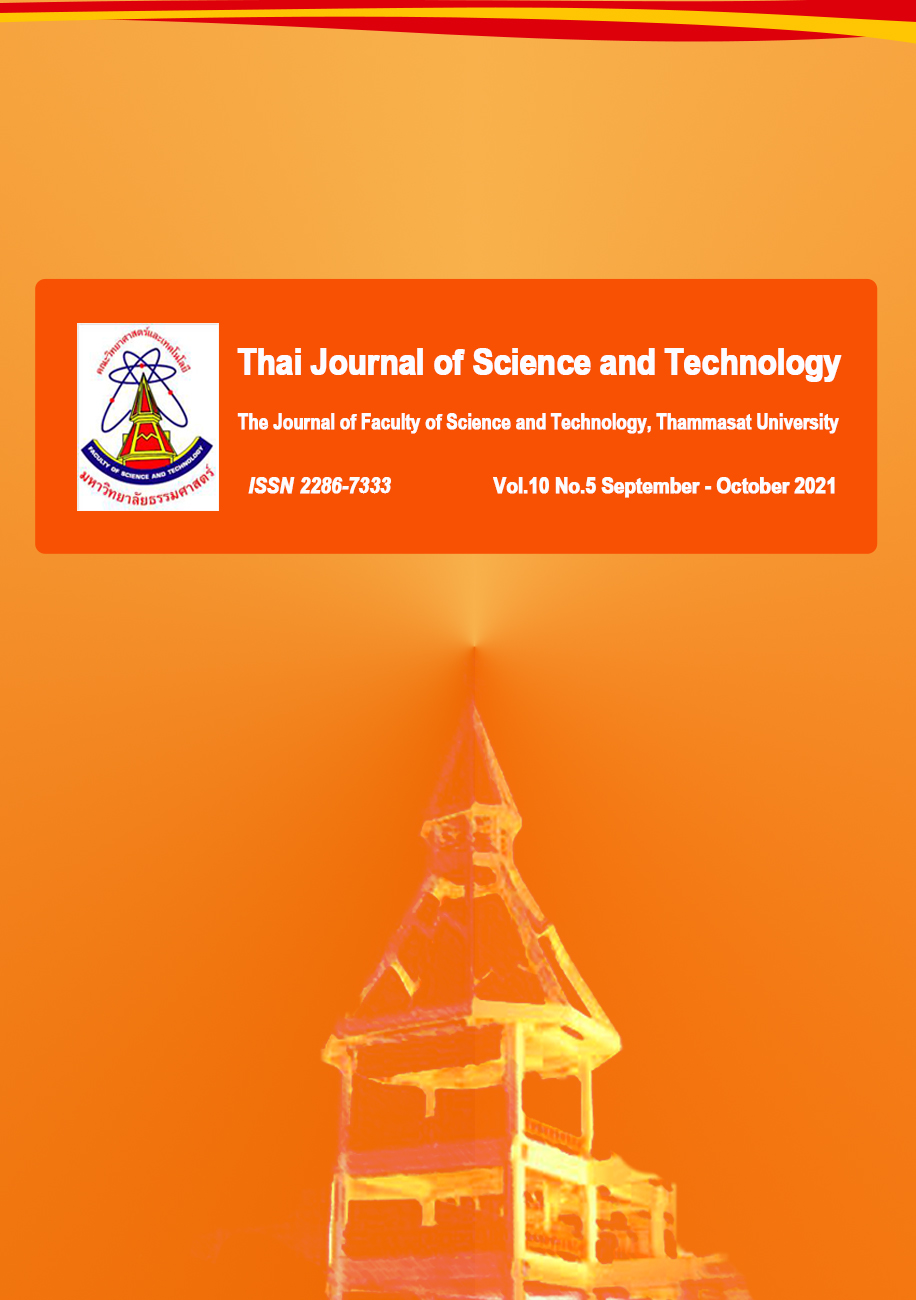Gelation Properties of Okra’s Extract and Its Application in Strawberry Jam
Main Article Content
Abstract
This research was to study application of okra’s extract (Abelmoschus esculentus (L.) Moench) to reduce sucrose content in strawberry jam. Optimum temperature for extraction of okra was investigated in 4 levels: 50, 60, 70 and 80°C. Physical analysis was determined by % yield, flowing distance and color values (Hunter L* a* b*). It was found that the optimum temperature for extraction was 60°C. Then, gelation properties of okra’s extract was investigated in 3 concentration levels of sucrose: 50, 60 and 70% (by weight of sugar per weight of okra’s extract) and 3 concentration levels of calcium chloride: 2, 2.5 and 3% (by weight of calcium chloride per total weight). Physical analysis was determined by flowing distance and color values (Hunter L* a* b*). It was found that ratio of sugar to calcium chloride at 50:2 had the least flowing distance (or the highest viscosity). Therefore, this ratio was used to study an appropriate ratio of okra’s extract to reduce sucrose content in strawberry jam. Okra’s extract content was varied in 3 levels: 20, 40 and 60% (by weight of Okra’s extract per total sucrose weight) and pectin content was varied in 2 levels: 0.5 and 1% (by total weight). It was indicated that ratio of sucrose to okra’s extract to pectin at 40:60:0.5 had the most spreadability and the highest flowing distance (or the least viscosity). Sensory evaluation were higher score in appearance and spreadability than that of the control sample. Therefore, this formula was selected to study chemical composition. The proximate analysis were 60.75±0.95% moisture, 0.45 ± 0.02% fat, 0.49 ± 0.01% fiber, 0.59 ± 0.02% protein, 4.26 ± 0.19% ash and 33.47 ± 0.76% carbohydrate by wet basis. The strawberry yam with ratio of sucrose to okra’s extract to pectin at 40:60:0.5 had the energy from calculation 31.49 % lower than that of the control sample.
Keywords: Okra’s extract; Yam product; Sugar; Calcium; Pectin; Gelation properties
Article Details

This work is licensed under a Creative Commons Attribution-NonCommercial-NoDerivatives 4.0 International License.
บทความที่ได้รับการตีพิมพ์เป็นลิขสิทธิ์ของคณะวิทยาศาสตร์และเทคโนโลยี มหาวิทยาลัยธรรมศาสตร์ ข้อความที่ปรากฏในแต่ละเรื่องของวารสารเล่มนี้เป็นเพียงความเห็นส่วนตัวของผู้เขียน ไม่มีความเกี่ยวข้องกับคณะวิทยาศาสตร์และเทคโนโลยี หรือคณาจารย์ท่านอื่นในมหาวิทยาลัยธรรมศาสตร์ ผู้เขียนต้องยืนยันว่าความรับผิดชอบต่อทุกข้อความที่นำเสนอไว้ในบทความของตน หากมีข้อผิดพลาดหรือความไม่ถูกต้องใด ๆ
References
Anonymous. (2010). Yam. [online]. Source: http://www.foodnetworksolution.com/vocab/ wordcap/%E0%B9%81%E0%B8%A2%E0%B8%A1. Accessed on 3 November 2012.
AOAC. (1995). Official Methods of Association of Official Analytical Chemist, 16th edition, Washington DC: Association of Analytical Chemist.
Axelos, M.A.V. and Thibualt, J.F. (1991). The Chemistry of Low Methoxyl Pectin Gelation, In The Chemistry of Pectin (Walter. R.H.Ed). New York: Academic Press. pp.109-118.
Bays, H. (2005). Combination Therapy for Global Lipid Improvement. The European Journal of Hospital Pharmacy, May/June, 1-3.
Berth, G., Voragen, A.G.J. and Pilnik, J. (1982). Pectin-based Oral Drug Delivery to the Colon. Study of the Methyl Ester Distribution in Pectin with Endo-polygalacturonase and High-performance Size-Exclusion Chromatography, Biopolymers, 58(2), 195-203.
Bhat, U.S., and Tharathan, R.N. (1987). Functional properties of okra (Hibiscus esculentus) mucilage, Starch/Starke, 39, 165-167.
Butsadee, K., Praputmatha, P. and Petchpankun, S. (2006). Production of Mucilage Powder from Okra. Research Report. Nakhon Pathom: Nakhon Pathom Rajabhat University, Thailand. 42 pp. (in Thai)
Chaowitayangku, N. and Poosaran, N. (1999), Making of low calory jam. Proceeding of The 37th Annual Meeting of Kasetsart University, 3rd-5th February 1999, pp. 3 - 9. Kasetsart University, Thailand. (in Thai)
Ndjouenkeu, R., Goycoolea, F. M., Morrisa, E. R., and Akingbala, J. O., 1996, Rheology of
okra (Hibiscus esculentus L.) and dika nut (Irvingia gabonensis) polysaccharides,
Carbohydrate Polymers, 29(3), 263-269.
Pornchaloempong, P. (2010). Yam. [Online]. Source: http://www.foodnetworksolution. com/vocab/wordcap/%E0%B9%81%E0%B8%A2%E0%B8%A1. Accessed on 3 November 2012. (in Thai)
Punnarunothai, R. (1999). Measurement of Speadability and Texture Analysis of Fat Products. [Online]. Source: http://www.Charpatechcenter.com. Accessed on 1 March 2013. (in Thai)
Sengkhamparn, N., Verhoef, R., Schols, A.H., Sajjaanantakul, T., Voragen, G.J.A. (2009).
Characterisation of cell wall polysaccharides from okra (Abelmoschus esculentus (L.)
Moench), Carbohydrate Research, 344, 1824–1832.
Sirikaew, S. (2011). Studies on processing KAI ALGAE yam. Master’s Project. M.Ed. (Science Education). Bangkok: Graduate School. Srinakharinwirot University. (in Thai)
Suthipolpaiboon, S. (1995). Okra for export. [Online]. Source: http://www.eto.ku.ac.th/neweto/e-book/plant/herb_gar/krajeab.pdf. Accessed on 21 September, 2012. (in Thai)
Woolfe, M. L., Chaplin, M. F., and Otchere, G., 1977, Studies on the mucilages extracted from okra fruits (Hibiscus esculentus L.) and baobab leaves (Adansonia digitata L.), Journal of the Science of Food and Agriculture, 28, 519-529.


